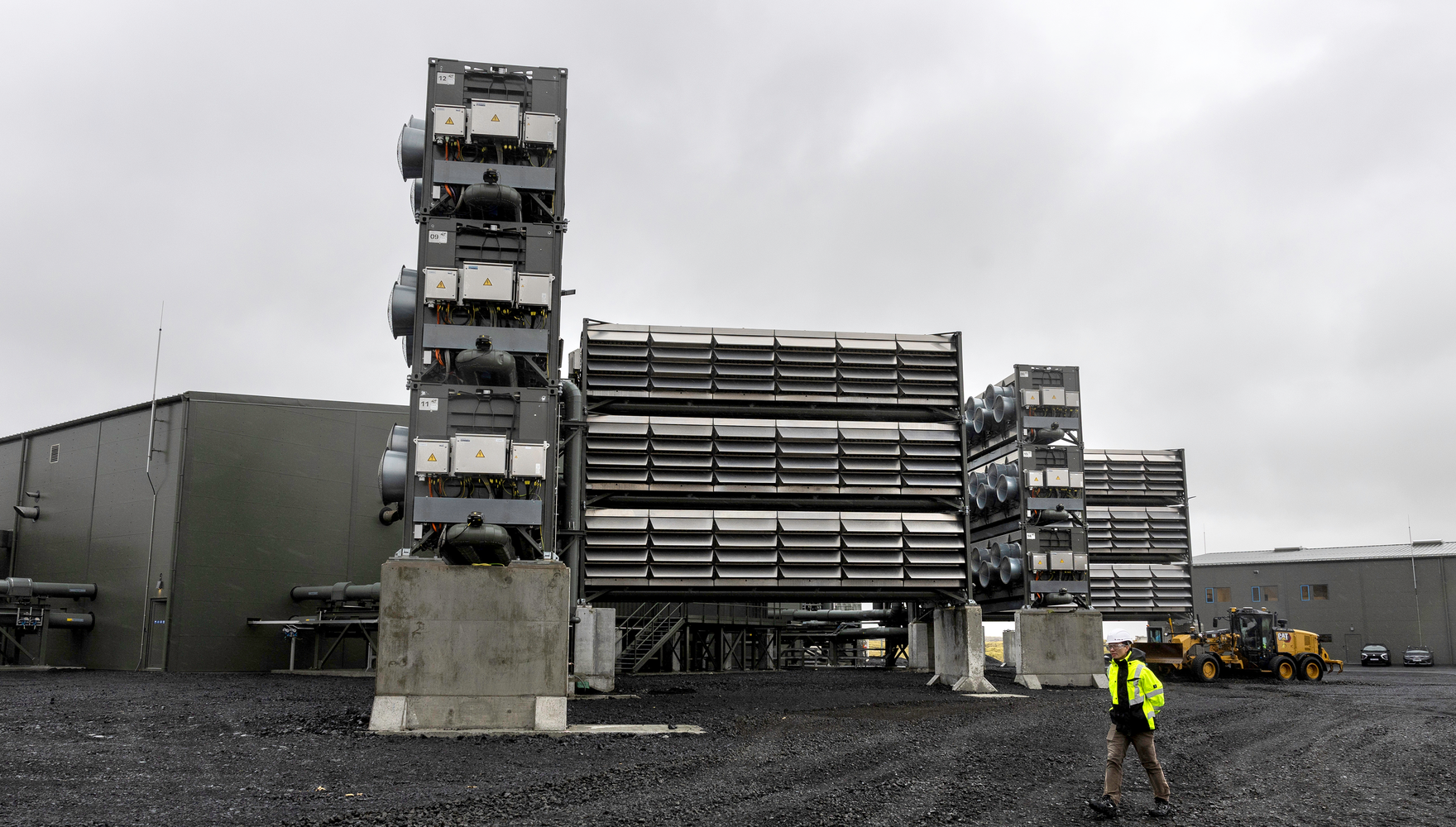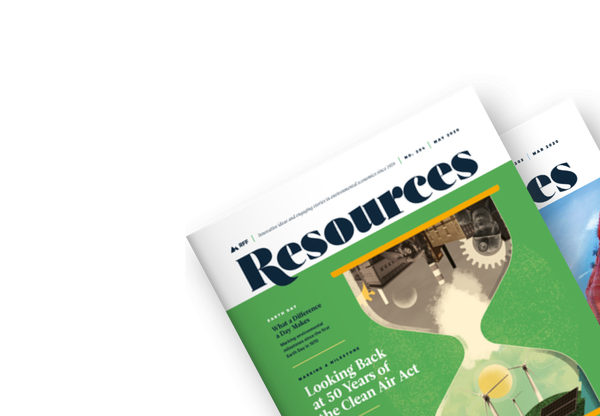In this week’s episode, host Daniel Raimi discusses carbon removal with Jennifer Wilcox, a professor at the University of Pennsylvania who recently coauthored a paper titled, “Elevating Carbon Management: A Policy Decision-Making Framework and Rubric for the 21st Century.” Wilcox discusses the existing gaps in current policies related to carbon removal and important considerations when amending and creating new policies. She also addresses the recent change to the 45Q subsidy (originally included in the Inflation Reduction Act of 2022 and revised by Congress in the budget reconciliation bill signed on July 4, 2025), assessing how the updated tax break offers incentives for carbon removal.
Listen to the Podcast
Audio edited by Rosario Añon Suarez
Notable quotes:
- Use of carbon dioxide removal for carbon management: “Carbon dioxide removal is really broad. It includes everything from planting trees to using chemicals to taking carbon dioxide out of the atmosphere.” (4:43)
- The potential flip side of solutions: “We need to be able to … get ahead of any unintended consequences. We don’t want to create, ultimately, more pollution with these solutions that we’re coming up with.” (11:20)
- Carbon capture should mitigate—not facilitate—carbon emissions: “If you look at the entire fleet of natural gas–fired power plants in the United States today, and you think about the question of carbon capture as a solution for that sector in terms of mitigating carbon emissions, you wouldn’t want to put carbon capture on a unit that should be retired … it shouldn’t be something that enables further dependence on fossil [fuels].” (17:10)
Top of the Stack
- “Elevating Carbon Management: A Policy Decision-Making Framework and Rubric for the 21st Century” by Jennifer Wilcox, Noah Deich, and Holly Jean Buck
- National Park Service Rehabilitation Tax Credits
The Full Transcript
Daniel Raimi: Hello, and welcome to Resources Radio, a weekly podcast from Resources for the Future (RFF). I’m your host, Daniel Raimi. Today, we talk with Dr. Jennifer Wilcox, the Presidential Distinguished Professor of Chemical Engineering and Energy Policy at the Kleinman Center for Energy Policy at the University of Pennsylvania. Jen is also a senior fellow at the World Resources Institute, and the chief scientist at Isometric.
Along with two coauthors, Jen recently published a report called “Elevating Carbon Management: A Policy Decision-Making Framework and Rubric for the 21st Century.” The report provides a guide to policymakers when they’re thinking about how to govern the removal of carbon dioxide from smokestacks and ambient air. I’ll ask Jen to describe what the key principles should be, evaluate one of the United States’ biggest carbon removal policies—called 45Q—and offer recommendations for the future. Stay with us.
All right, Jen Wilcox from the University of Pennsylvania, World Resources Institute, and Isometric—you are a woman of many hats. Welcome to Resources Radio.
Jennifer Wilcox: Thank you.
Daniel Raimi: So, Jen, we always ask our guests how they became interested in working on environmental issues—whether you had some early in life inspiration or whether you came to these topics later in your life. So I’m curious: What drew you into the field?
Jennifer Wilcox: Well, for me, it was early in life. I’m from rural Maine, and I grew up in a community that was very sustainable leaning—neighbors with solar panels and batteries. This was a long time ago, when you had to bring batteries in with cranes because they were so large. It was just a way of living, and it made a lot of sense to me, and you sourced food and resources that you needed locally.
Even later when I was in college, I studied in New Zealand. And when I went there—you’re on an island, and everything is difficult to get unless you can get it locally. It reminded me a lot of growing up in Maine; it just makes sense to me.
I also grew up being very interested in how things work, my natural environment around me, and the concept of being able to use the energy from the sun for your own purposes. Even, How can you harness electricity from lightning? Just thinking about all of these things, and about accessing and resourcing.
That also brought me to what I ended up studying in school. I was a math major as an undergrad and also studied a ton of chemistry. And then I ended up going into chemical engineering, and it felt like the perfect field for me, because the first course I took was chemical and material energy balances.
What it does is it provides you with all the fundamentals of the math and of understanding the materials that you use in your life, the energy that you use in your life, where is it coming from, and understanding environmental impacts associated with that.
I was pretty much hooked. And that kind of way of how I grew up, combined with the field of chemical engineering and the tools that I learned, is really how I shape the work that I do today.
Daniel Raimi: That’s really interesting. Well, you’ve ended up going on to do work on all sorts of topics, and one of them is carbon removal—which is what we’re going to focus on today.
I don’t think we need to review what carbon removal is, because we’ve talked about it quite a bit before on this show. But I’m curious to hear why you and your coauthors, Noah Deich and Holly Buck (Holly Buck, who we’ve had on the podcast before)—why you wrote this piece. So, from your perspective, why is it important that we set a framework for evaluating carbon removal policies?
Jennifer Wilcox: Yeah, so I took three and a half years’ leave from my academic role and served in the Biden administration. In that position, we were essentially taking all of the policies that existed and doing our best to kind of piece things together to scale up carbon removal. And it felt, at that time, that there wasn’t a right policy that fit everything we were trying to do. In some cases, with carbon removal, there were just significant gaps in existing policy, so there was no incentive to be able to move some of the approaches forward.
Carbon dioxide removal is really broad. It includes everything from planting trees to using chemicals to taking carbon dioxide out of the atmosphere. Given the very, very broad range of topics associated, we had to be thinking about, “Okay, how do we make sure that we can do these things in an economic way?” Economic so that they’re ultimately scalable, because that’s what we need to do, is get them to a significant scale, ultimately for them to contribute to our climate goals.
The other piece, though, that was important is recognizing that, in cases where we did have policy for approaches that were more quantitative for removing carbon—for example, direct air capture, when I mentioned using chemicals—in that case, we can really quantify the carbon that we take out of the atmosphere.
We also have approaches in place where we know how to drill wells; we know how to put carbon dioxide deep underground; we know how to monitor and report and verify that the carbon is stored deep underground.
All of that is in place through a combination of approval processes through the Environmental Protection Agency (EPA), through Class VI wells. And then the Department of Energy was really the side of things where we provided the economic incentives, the programs, and the dollars at the end of the day for those projects to be developed and to move forward.
But the issue with that one in particular is that you are the grantees—the ones that are the project developers. At the end of the day, when we look at carbon sequestration, they’re fossil fuel companies. So, there’s a question of trust with that industry. And I think—from the perspective of communities who have been negatively impacted by the extraction of coal, oil, and gas and how we’ve used those historically—those energy resources that mistrust naturally leads to, well, wait a minute: These companies came in, and they extracted these resources out of these rocks, and now you’re telling me you want to put carbon in the same rocks. How can I trust that this is going to be safe? How can I trust that it’s not going to leak into my drinking water? There’s all of these questions.
So, it’s really important that, when we look at EPA Class VI, and at the monitoring, reporting, and verification, and understanding all of those aspects of the regulatory framework, but also the policy, and the dollars that are going to pay the developers to do these projects, that there’s a responsibility such that we’re not creating more environmental hazards, more pollution, more negative climate impacts than what we’re actually trying to fix.
So, looking at all of the policies in place and the rubric that we developed, what we wanted to do is articulate, Where are the gaps? How do you quantify the carbon removed from planting a tree in a certain region? How do you quantify and ensure that the carbon that’s put underground is going to stay underground? And how do you also make sure that the costs of doing all of this falls equitably across those that are involved—whether it’s the developer or, at the end of the day in the case of carbon capture on a power plant, maybe the ratepayer.
It’s all of these aspects for us. They’re just not perfect tools, the policies that are in place. And so we wanted to shed light on developing the rubric of well, What are all of the key pieces? And then how do they kind of fail? And how might we, in future opportunities, try to improve these policies so that they actually are safeguarding and actually are contributing to our climate goals, at the end of the day, and minimizing environmental hazards?
Daniel Raimi: Right. Well, you’ve just touched on this, but I’d love to ask you to say a little bit more about the importance of aligning carbon removal strategies with other social and environmental objectives. So, can you talk a little bit about specifically what those objectives might be? And why is it important that carbon removal efforts align with those social and environmental goals?
Jennifer Wilcox: Absolutely. So one aspect (I get excited about this piece, because I think there’s so much opportunity with carbon capture in general) when you develop these technologies to capture carbon is that there’s a lot of opportunities to capture other pollutants with the same materials. And that’s fun because, again, I’m a chemical engineer by training, and that’s kind of the fun, creative piece associated with all of this work.
So, when you’re thinking about direct air capture, and you’re thinking about where you want to cite one of these direct air capture units, we often think, “Well, we need to make sure we’re co-located to where we can put the carbon underground so that you don’t have to spend the effort to transport the carbon dioxide.” But you can also imagine putting them in places with high pollution. Some of the materials that are used for direct air capture—the materials are called solid sorbents, and they are functionalized with a certain chemistry called amines.
This type of chemistry has the ability not just to capture carbon dioxide, but it can capture sulfur oxides and nitrogen oxides—precursors to acid rain. So, you can imagine siting direct air capture in places, maybe in a port or somewhere that we know is polluting, and it’s difficult to avoid the pollution—we can actually reduce the pollution and really have this co-benefit.
The other aspect I think is interesting in some of these cases, too, is that you can produce water with solid sorbents as kind of a co-product, because you’re actually taking some of the water out of the atmosphere, as well. But there’s this flip side: As we’re developing these chemistries, what are the degradation properties of these materials? Is it possible that those amines, or parts of these materials, could degrade over time? These are systems that are outside, and they’re exposed to all kinds of harsh conditions depending on where they’re located.
So, we need to be able to understand, too, what the degradation process looks like for these systems, so that we get ahead of any unintended consequences. We don’t want to create, ultimately, more pollution with these solutions that we’re coming up with.
To me, that work—it’s beyond developing new materials at this stage. We have a ton of materials out there that are now being piloted and demonstrated, but what we need to do is kind of understand their performance over time. And then the research and development looks more like, “Okay, how can we make sure that these are lasting? And if we do have to recycle them, how are we going to do that in a way that’s minimizing environmental impacts?” So, thinking of their life and end of life.
The other piece I think that’s important to think about is—it goes back to what I said about communities and trust of fossil fuel companies—there’s legacy impacts that communities are still feeling, of course, from extraction of gas, extraction of oil, and then also how we use gas and oil.
Oftentimes, natural gas—we use it for heat and power—it’s often used to make all of the plastics in the chemicals that we rely on. Natural gas is often a feedstock for petrochemicals, and we have them in our lives every day. Our cell phones, our furniture, our rugs, our everything is made out of these materials. And those petrochemical facilities are very polluting. Same with refineries associated with oil refining for the liquid fuels that we depend on.
So, those communities really have these stacked burdens where, again, it’s where the rocks are and where we produce the oil and gas. Then these same communities are impacted by the refineries and the petrochemical facilities that process the natural gas and oil to make the products that we use. Here we are, saying, “Well, now we’ve got this carbon dioxide that we have to deal with and those rocks that we took the hydrocarbons out of—those are the ones that we want to put the carbon back into.”
And so, I think the first step is that these energy companies, the fossil fuel companies, recognize that they’re the ones with the expertise and the resources to put the carbon back, but there also needs to be this trust building in these early days. And it might be that we look at cleaning up some of those legacy impacts ahead of even putting the carbon back in, and that would be restorative justice. So, recognizing that there are these impacts that were felt—are still being felt—in some of these communities. And it may be something as simple as—which is what’s happening in the northern part of California—having sulfur scrubbing at refineries. Not all refineries have that kind of pollution control in place, but they should.
There’s steps that can be taken that can reduce pollution, that can help to heal communities. And when that takes place, we can be in a position where communities can start to feel trust from the energy industry that’s hopefully pivoting. When that happens, then we’ll be in an easier position to be able to do geologic storage in these regions where these really great rocks are that can store CO₂ for millions of years, ultimately.
Daniel Raimi: Right. That’s all really useful. Let’s get into some of the specifics that you outline in your recent publication with your coauthors, which include 10 specific criteria that you identified that can help fulfill the sort of multiple objectives that you’ve been talking about. We don’t have time to go into all of them in depth, of course, because we have a relatively short podcast here. But can you maybe give us a speed run through those 10 criteria?
Jennifer Wilcox: Sure, I can go through each of them.
One is business case. And so, what business case means—you can look at an example like the tax credit 45Q, and making sure that it’s just economically priced so that, at the end of the day, it makes a first-of-a-kind and second-of-a-kind viable from an economic perspective. Just briefly, if it’s point source capture—so, capturing carbon dioxide at the source and preventing the carbon from ever entering the atmosphere—it’s $85 a ton. And then for taking CO₂ out of the atmosphere, like direct air capture, it’s $180 per ton. So, those are pretty good price points for those two approaches.
Then, another criterion for the rubric was climate importance. So, really asking the question, If there are alternatives to mitigating the carbon or capturing the carbon, then maybe carbon management isn’t the best solution.
Looking at some concepts like industrial decarbonization, to give an example—when we think about cement and steel, cement and steel have carbon emissions—it doesn’t have to do with fossil fuels, it has to do with the chemistry of the feedstock. When you’re making cement, for instance, you start with limestone, you heat limestone, and you’re actually chemically making CO₂ from limestone. So, in that case, it’s not just simply a matter of, “Oh, well, we don’t need fossil fuels. We can use renewables.” It’s not a simple switch out. So, carbon capture is really a single approach to mitigating carbon emissions from how we make cement today. And so that would be an example of climate importance, because there’s not really an alternative approach today.
Unabated fossil fuel decoupling (so this is a little bit related to what I just said)—if you look at the entire fleet of natural gas–fired power plants in the United States today, and you think about the question of carbon capture as a solution for that sector in terms of mitigating carbon emissions, you wouldn’t want to put carbon capture on a unit that should be retired. If you have a new natural gas–fired power plant, and it has a future life of 30 years, then it would make sense to put carbon capture, but it shouldn’t be something that enables further dependence on fossil when the fossil should simply be retired. So kind of decoupling.
A fourth one is environmental health and safety. That goes back to a little bit, too, of Class VI and making sure that, when you’re putting carbon dioxide deep underground, there’s long-term monitoring, reporting, and verification associated with that carbon and we know where it’s going. And it also could have to do with, too, what I mentioned a little bit earlier, of ensuring that the carbon capture and the chemistry is not posing more hazards, and understanding the degradation process.
Daniel Raimi: Right. And just in case listeners are not totally sure about what Class VI refers to, this is the class of wells that the EPA regulates for the injection of carbon dioxide deep underground.
Jennifer Wilcox: Absolutely. A fifth one is communities. Asking the question when you’re thinking about a project, Are local communities involved in the siting decisions in terms of economic benefits? What are the revenues? How are they falling to the communities? Is it in terms of jobs and job creation? So, that’s another aspect.
Six is storage. And this isn’t just necessarily geologic storage of CO₂, but it could also be, as I mentioned before, in terms of carbon dioxide removal—it’s very broad. Anything from planting a tree to another method, which is called enhanced rock weathering, where you can take magnesium-rich feedstocks and add it to soils to take the carbon from the soils and actually form bicarbonate into pore water. Then, ultimately, that bicarbonate travels through the hydrological system and ends up in the ocean. So there’s a ton of approaches in terms of carbon dioxide removal, and that one that I just described is more of an open system versus, say, direct air capture.
So, there’s an open question of, How durable is the carbon that’s stored in that system, and on what time scales? So, thinking about how we build in MRV (which is monitoring, reporting, and verification), not just for geologic storage as we have in the Class VI EPA process, but the broader suite of carbon removal approaches in that MRV piece.
Number seven is renewables competition. So (this you hear often of) things like carbon capture, direct air capture, and point source capture require a lot of energy. And if you’re going to be using energy for those systems, that’s energy that potentially could help to take a fossil fuel–fired power plant off the grid.
So, there’s this competition for those kinds of green electrons. Are you using it for decarbonization, which should be first and foremost, or are you kind of stealing those electrons for your direct air capture? And so for that, it’s just really asking the question of this policy (whatever it might be), Is it helping to safeguard against renewables competition?
Daniel Raimi: Yeah, that’s really interesting. It reminds me of the economic concept of opportunity cost. It’s like, Is there an opportunity cost of installing this carbon removal system in terms of electricity consumption? So just for our econ-minded listeners, maybe that’s one way to frame it.
Jennifer Wilcox: Yeah. And eight is scalability, so asking if there are limited resources that are needed for the technology to actually scale meaningfully. Does the policy support the demonstration only at the pilot, or is it able to get to the first of a kind and, ultimately, to commercial scaling? So, asking that question.
Number nine would be global linkages. So, thinking about sharing technology and financing with emerging economies to ultimately enable global emissions reductions.
Finally, the cost to consumers. If you’re thinking about the policy and the incentives at the end of the day, if there’s a gap economically, who is that gap for? Who’s paying for that? Is it consumers? Or is it the suppliers? Ensuring that the policy is developed in a way that safeguards against that.
Daniel Raimi: Yeah, that’s great.
Jen, let’s look at one specific policy that you’ve referenced already in our conversation, which is the 45Q tax credit on carbon capture and direct air capture. It was amended in the recent One Big Beautiful Bill Act to increase the credit for the use of captured carbon to increase oil production. So when you apply the 10 criteria that you’ve just laid out for us, what are some of the key strengths and some of the key weaknesses of 45Q?
Jennifer Wilcox: Yeah, so I will just say that in this One Big Beautiful Bill Act for increasing the credit, it’s true that it’s increasing it for EOR, enhanced oil recovery, but it’s actually increasing it more broadly to utilization. I think it’s an important distinction to make.
What that means is, when you look at, again, if the carbon is sourced from a point source—so, it could be from a steel plant or a cement plant—the dollar amount is $85 per ton. And, as you said, whether or not the CO₂ is injected in a Class VI well deep underground, it’s $85 a ton. If the CO₂ is used for enhanced oil recovery, the CO₂ is still stored underground, but it’s also, as you noted, producing oil as well.
But the other utilizations are also interesting. So, you can use the CO₂ as a chemical feedstock for sustainable aviation fuel and chemicals, which lowers our dependence on, say, natural gas or crude oil for making those products.
You can also use the CO₂ as a chemical feedstock for a synthetic aggregate, which you could use for concrete and building materials. Now, that’s if the CO₂ is sourced from a point source where it’s mitigating—if you flip it, and you take the CO₂ out of the atmosphere, now it looks different, and it’s $180 a ton.
And yes, you can use it for enhanced oil recovery, but you could also use it for those same purposes that I mentioned, such as sustainable aviation fuel. When you start to look at $180 a ton instead of $85 as a feedstock for CO₂ for sustainable aviation fuel, it actually starts to look pretty interesting. I actually think that this extension of 45Q is such that there’s an equal value of 45Q for both utilization and storage. We’re going to see more routes of utilization open up, and I’m actually really excited about that.
Daniel Raimi: That is really interesting. I hadn’t realized that. I’m really glad you pointed it out. So, Jen, we’re running close to time. I want to ask you a final question before we go to Top of the Stack about the recommendations that you and your coauthors make with regard to future policymaking around carbon removal. There’s a bunch of them in this report, and so we don’t have time to go into all of them, but I’m wondering if you can highlight maybe two or three for our listeners.
Jennifer Wilcox: Sure. Well, I’ll go to 45Q again. I think right now, the way that 45Q looks, it’s essentially over 12 years, but many of these projects are financed over, say, two decades. So, an extension of 45Q, so that we have more durability in the financing would be good.
And there’s not a lot of talk or a lot of action on leveraging 45Q for biomass-conversion processes like biomass gasification, for instance. It would be good to see more activity in that space. There’s a lot of waste biomass associated with agriculture, some of the forests work that can reduce forest fire risk, and I think that there’s a lot of opportunity for jobs in those sectors.
Hopefully we’ll see more activity in that space because, as I talked about CO₂ being a chemical feedstock, now that we have this utilization opening, hydrogen can also be a chemical feedstock with CO₂. So, we might see that.
In terms of the recommendations, I would also add that it would be wonderful someday to see special incentives with 45Q for hard-to-abate sectors in particular. So, cement, steel, and even pulp and paper, which could have some removals built in. So, these are supply chains that we all depend on, and it would be wonderful to kind of see some special attention associated with those.
Daniel Raimi: Those are all really interesting ideas and definitely ones that we’ll be paying attention to in the years ahead. And maybe we’ll have you back to talk about how things are going in a few years.
Well, one more time, Jen Wilcox from University of Pennsylvania, thanks so much for coming onto the show.
I’d love to ask you now about the things that you’ve been reading, watching, or listening to that you think are great, and that you think our listeners might enjoy. So, Jen, what’s at the top of your literal or your metaphorical reading stack?
Jennifer Wilcox: Well, it might be more metaphorical because, for me, I’ve been kind of digging in and going back to my main roots.
One of the things that we’re doing now, we have this old house in Philadelphia on a few acres, actually, which is rare here—it’s from 1925. What I’ve been spending my time reading is the National Park Service Rehabilitation Tax Credits. We are rebuilding this house to align, and rehabilitate, and kind of bring it back to life, but in a way that it’s net zero.
We’re putting on a solar roof, but we have to do everything in a way that aligns with the Park Service, and the historical nature and preservation of the house. And it’s fascinating.
I’m kind of close to home right now and trying to understand this whole process, and that whole application process, but it’s pretty exciting. It’s been keeping me busy, and it’s actually getting our community really talking, and we might see more of these old homes being restored and rehabilitated in the same way, which is exciting.
Daniel Raimi: That’s really cool. Maybe next time I’m in Philadelphia, I’ll look you up and see if I can come check it out.
Jennifer Wilcox: Yeah.
Daniel Raimi: That sounds really great. And any of our listeners who are involved in home remodeling projects, I’m sure they’ll enjoy checking that out, too.
Well, one more time, Jen Wilcox, thanks so much for coming out to the show and sharing this really valuable information. It’s been fascinating.
Jennifer Wilcox: Thanks for having me.
Daniel Raimi: You’ve been listening to Resources Radio, a podcast from Resources for the Future, or RFF. If you have a minute, we’d really appreciate you leaving us a rating or a comment on your podcast platform of choice. Also, feel free to send us your suggestions for future episodes.
This podcast is made possible with the generous financial support of our listeners. You can help us continue producing these kinds of discussions on the topics that you care about by making a donation to Resources for the Future online at rff.org/donate.
RFF is an independent, nonprofit research institution in Washington, DC. Our mission is to improve environmental, energy, and natural resource decisions through impartial economic research and policy engagement. The views expressed on this podcast are solely those of the podcast guests and may differ from those of RFF experts, its officers, or its directors. RFF does not take positions on specific legislative proposals.
Resources Radio is produced by Elizabeth Wason with music by me, Daniel Raimi. Join us next week for another episode.









